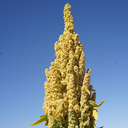Search
About Chenopodium quinoa
Chenopodium quinoa (Quinoa) is a highly nutritious crop that is adapted to thrive in a wide range of agroecosystems. It was presumably first domesticated more than 7,000 years ago by pre-Columbian cultures and was known as the Inca ‘mother grain’. It is an allotetraploid (2n=4x=36). Quinoa has adapted to the high plains of the Andean Altiplano (>3,500 m above sea level), where it has developed tolerance to several abiotic stresses. Quinoa has gained international attention because of the nutritional value of its seeds, which are gluten-free, have a low glycaemic index, and contain an excellent balance of essential amino acids, fibre, lipids, carbohydrates, vitamins, and minerals. It has the potential to provide a highly nutritious food source that can be grown on marginal lands not currently suitable for other major crops. This genome corresponds to coastal Chilean quinoa accession PI 614886, also known as NSL 106399 and QQ74.
Taxonomy ID 63459
Data source King Abdullah University of Science and Technology
Comparative genomics
What can I find? Homologues, gene trees, and whole genome alignments across multiple species.
 More about comparative analyses
More about comparative analyses
 Phylogenetic overview of gene families
Phylogenetic overview of gene families
 Download alignments (EMF)
Download alignments (EMF)
Variation
This species currently has no variation database. However you can process your own variants using the Variant Effect Predictor:





 Display your data in Ensembl Plants
Display your data in Ensembl Plants

 Update your old Ensembl IDs
Update your old Ensembl IDs

![Follow us on Twitter! [twitter logo]](/i/twitter.png)
